Article contents
On receptivity of marginally separated flows
Published online by Cambridge University Press: 17 November 2020
Abstract

In this paper we study the receptivity of the boundary layer to suction/blowing in marginally separated flows, like the one on the leading edge of a thin aerofoil. We assume that the unperturbed laminar flow is two-dimensional, and investigate the response of the boundary layer to two-dimensional as well as to three-dimensional perturbations. In both cases, the perturbations are assumed to be weak and periodic in time. Unlike conventional boundary layers, the marginally separated boundary layers cannot be treated using the quasi-parallel approximation. This precludes the normal-mode representation of the perturbations. Instead, we had to solve the linearised integro-differential equation of the marginal separation theory, which was done numerically. For two-dimensional perturbations, the results of the calculations show that the perturbations first grow in the inside of the separation region, but then start to decay downstream. For three-dimensional perturbations, instead of dealing with the integro-differential equation of marginal separation, we found it convenient to work with the Fourier transforms of the fluid-dynamic functions. The equations for the Fourier transforms are also solved numerically. Our calculations show that a three-dimensional wave packet forms downstream of the source of perturbations in the boundary layer.
- Type
- JFM Papers
- Information
- Copyright
- © The Author(s), 2020. Published by Cambridge University Press
References
REFERENCES
- 1
- Cited by





